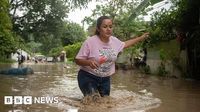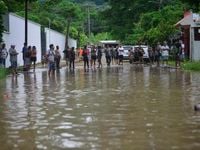Heavy rains and catastrophic flooding swept through central and southeastern Mexico this week, leaving devastation in their wake and claiming at least 37 lives, according to Mexican authorities. The deluge, which began on October 9 and continued into the weekend, triggered landslides, destroyed thousands of homes, and left entire communities cut off from rescue efforts.
According to civil defence officials cited by AFP and BBC, the worst-hit states include Hidalgo, Puebla, Veracruz, and Queretaro, though intense rainfall was reported in 31 of Mexico’s 32 states. In Hidalgo alone, at least 22 people have died, with officials warning that the death toll could rise as dozens remain missing and more than 90 communities are currently inaccessible. The state’s interior secretary, Guillermo Olivares Reyna, told reporters on Friday that “at least 1,000 homes, 308 schools, and 59 hospitals have been damaged.”
Puebla, east of Mexico City, also suffered significant losses, with nine confirmed fatalities and as many as 13 people still missing. Governor Alejandro Armenta reported that about 80,000 people in Puebla have been affected. “A gas pipeline was ruptured by a landslide,” he added, underscoring the widespread infrastructural damage. He pleaded for federal assistance to rescue at least 15 people, including children, stranded on rooftops by raging floodwaters.
Veracruz, on the Gulf of Mexico, reported five deaths, including a police officer, and about 5,000 homes damaged. The city of Poza Rica was particularly hard-hit, with rivers overflowing and streets completely submerged. The Navy evacuated nearly 900 people to shelters, and authorities cut electricity as a precautionary measure. In Queretaro, a child died after being caught in a landslide, according to local officials.
The disaster was not limited to fatalities and property damage. Power outages swept across the region, affecting more than 320,000 users in six states and damaging nearly 1,000 kilometers (about 621 miles) of roads. Two bridges and over 600 miles of federal highways were rendered impassable, as reported by the Mexican government. In Hidalgo, 17 municipalities lost electricity, and 90 communities were left without communication. The devastation of infrastructure has made rescue and relief efforts especially challenging.
President Claudia Sheinbaum has been at the forefront of the government’s response, sharing images of emergency responders wading through knee-deep water to deliver supplies. She stated after a meeting with local officials and cabinet members, “We are working to support the population, open roads and restore electrical services.” According to The New York Times, Sheinbaum also ordered the suspension of all classes in Hidalgo due to the ongoing crisis.
To tackle the scale of the disaster, the Mexican government has deployed more than 8,700 military personnel, including 3,300 naval troops, to monitor, evacuate, and clean up affected areas. The Navy has carried out more than 900 evacuations and provided critical resources: 18 vessels, six helicopters, three water purification plants, three aircraft, three mobile kitchens, and 4,000 food baskets, according to an official statement shared by Sheinbaum on social media. Shelters have been opened for those displaced from their homes, and the Army, Air Force, and National Guard have activated more than 5,400 troops to assist in rescue and recovery operations.
The Sierra Madre Oriental, a mountain range running parallel to the Gulf of Mexico, has borne the brunt of the destruction. Many small communities in this region have been blocked off by landslides and flooding. Photos posted by Hidalgo’s infrastructure officials show roads covered in rocks and branches, with workers laboring to clear debris amid ongoing rain. In Veracruz, the University confirmed that a student had died, adding to the mounting toll in the region.
Scenes recorded by residents and shared on social media paint a grim picture: streets turned into rivers, cars and even houses swept away by fast-moving water, and families forced to abandon their homes in the dead of night. Jose Cervantes, a coffee shop owner in one of the affected areas, told Reuters, “No one was prepared for this. The flood reached a height of one and a half meters. Everything was flooded—the dining room, the entire restaurant, the kitchen, the bathroom, the games room, the private area. Everything is in terrible condition.”
The cause of the extreme weather has been linked to several meteorological phenomena. The national coordinator for civil defence, Laura Velazquez, attributed the rainfall to a combination of a tropical disturbance from the Gulf and the effects of Post-Tropical Cyclone Priscilla and Tropical Storm Raymond, both lingering off Mexico’s Pacific coast. The United States National Hurricane Center warned that Raymond, the third such system in a week, was expected to make landfall in Mexico on Sunday, October 12, and would likely weaken to a tropical depression by then. Meanwhile, remnants of Tropical Storm Priscilla continued to dump heavy rains on western Mexico, affecting states such as Chiapas, Guerrero, Oaxaca, and Michoacan.
Adding to the complexity, meteorologists have noted the return of the La Nina weather pattern in the Pacific Ocean. According to AFP, La Nina can warp weather worldwide and intensify hurricanes, raising concerns that such extreme rainfall events could become more frequent or severe. While it may be too late in the Atlantic hurricane season for La Nina to have a significant impact this year, experts warn that its effects could still be felt globally—from heavy rains to droughts in other regions.
As the weekend approached, forecasters cautioned that the storms could bring further heavy rain and flash flooding, not just in Mexico but even across the border into the deserts of the American Southwest. Authorities in the Pacific coastal states remained on high alert, closely monitoring Raymond and the remnants of Priscilla for any additional threats.
Mexico has experienced particularly heavy rains throughout 2025, with a rainfall record set in the capital, Mexico City, earlier this year. The scale of this latest disaster has brought renewed focus to the country’s vulnerability to extreme weather, especially in remote and mountainous regions where rescue operations are hardest to carry out.
For now, the focus remains on search and rescue, restoring basic services, and providing shelter and aid to the tens of thousands whose lives have been upended. As President Sheinbaum put it, “We are working to support the population, open roads and restore electrical services.” The coming days will test the resilience of both the authorities and the communities as they grapple with the aftermath of some of the worst flooding in recent Mexican history.



